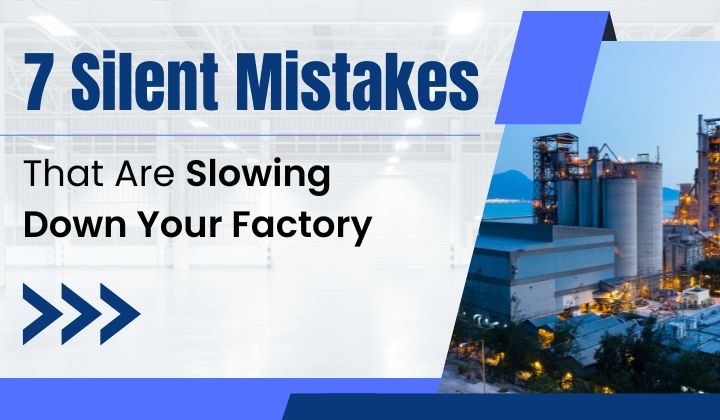If you’ve ever felt like your factory is “busy” all day but still underperforming — you’re not alone.
I’ve walked through hundreds of shop floors across India. Different industries, different products — but the same pattern: Teams working full shifts. Machines running non-stop. Yet… output isn’t what it should be.
Why does this happen?
Because factories rarely slow down due to one big problem. They bleed through small, silent mistakes — the ones that go unnoticed because they’ve become part of the routine.
Let’s talk about the 7 biggest ones I see again and again — and how to fix them.
1. No Standard Work = No Predictability
In most factories, two operators doing the same job will do it completely differently.
No surprise then that output, quality, and time all fluctuate.
Without standard work, your factory can’t improve — because there’s no fixed baseline.
Fix It:
Design clear step-by-step processes for every key activity. Train your team to follow them. Review and improve them regularly.
2. Changeover Delays That Kill Hours Daily
Every time your team switches products, there’s a delay — for approvals, tool changes, setup.
We’ve seen factories lose 2–3 hours every day just in changeovers.
Fix It:
Apply SMED (Single-Minute Exchange of Dies) principles. Create pre-checklists, assign clear roles, and prepare setups in advance.
3. No Visual Controls = No Ownership
If an operator doesn’t know what the daily target is… how do they know they’re on track?
Lack of visual controls leads to confusion and low accountability.
Fix It:
Install simple hourly boards, color-coded tags, and visual alerts at every station. Let performance be visible — and self-correcting.
4. Skipping Daily Floor Reviews
Factories that don’t do daily reviews keep repeating the same mistakes.
Downtime, defects, delays — all slip through the cracks.
Fix It:
Create a short 15-minute review routine with your supervisors. Track 3-4 key metrics daily, fix issues, and close the loop.
5. No Skill Matrix = Team Bottlenecks
If only one person knows how to run a machine, what happens when they’re absent?
You lose time, output, and flexibility.
Fix It:
Build a skill matrix. Cross-train your team. Create backups for every critical operation.
6. Chasing More Machines Instead of Better Flow
One of the most expensive mistakes: thinking a new machine will solve a flow problem.
Before investing in CapEx, ask — is your current setup running at 100%?
Fix It:
Line balancing, layout design, and flow optimization often unlock 20–30% more output — without new machines.
7. No Real-Time Visibility of Key Metrics
Most factory owners look at production data after the day ends — or worse, after the month ends.
But by then, it’s too late to fix what went wrong.
Fix It:
Implement basic digital or manual dashboards. Track output, downtime, rejection, and WIP in real-time. What gets measured gets improved.
Final Thoughts:
None of these mistakes sound dramatic. And that’s exactly why they’re dangerous.
Because they happen in silence — until one day, you realize you’ve been leaking profits for months.
The good news?
Fixing them doesn’t need new machines, big budgets, or 6-month projects.
It needs better systems, better visibility, and a factory culture that values small, daily improvements.
I’ve helped factories reduce rejection by 45%, improve output by 25%, and save crores in hidden losses — all by fixing these silent gaps.
Want to know which mistake is costing your factory the most?
On Discover How to Speed Up Production Without Expanding or Costly Upgrades


